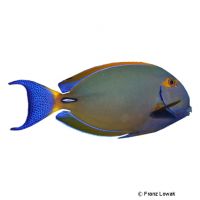Spotted-face Surgeonfish (Acanthurus maculiceps)
| Spotted-face Surgeonfish Acanthurus maculiceps | |
|---|---|
| Name | Spotted-face Surgeonfish |
| Name Lat. | Acanthurus maculiceps |
| Family | Surgeonfishes |
| Family lat. | Acanthuridae |
| Order | Surgeonfishes |
| Order lat. | Acanthuriformes |
| Origin | Indo-West Pacific |
| Habitat | Seaward reefs |
| Diet | Herbivore |
| pH | 8.1-8.4 |
| Hardness | 8-10 °KH |
| Behavior | Semi-aggressive |
| Keeping | Pair, group |
| Reef Compatible | Yes |
| Care Level | Difficult |
| Life Span | 2-3 years |
| Protection | No |
| Metric Units | |
| Size | 35 cm |
| Temperature | 22-28 °C |
| Salinity | 33-36 ‰ |
| Aquarium | ~ 1.400 l |
| US Units | |
| Size | 14" |
| Temperature | 72-82 °F |
| Salinity | 1.020-1.025 sg |
| Aquarium | ~ 360 gal |
Distribution and habitat
The range of Acanthurus maculiceps is coral reefs in the Indo-Pacific and Western Pacific Oceans, from the Maldives to Samoa, where they mostly live on outer reefs and shallow reef terraces.
Maintenance
They require a well-structured aquarium with plenty of swimming space and a reef structure (hiding, resting and retreat possibilities) with living stones which they can graze on and which act like a biological filter. Only lime-rich, heavy metal-free sands, gravels, stones or sea sand of various grain sizes may be used as substrate
Filters, skimmers and heaters are necessary to ensure water quality, as well as pumps to simulate tides, swells and bottom currents. Lighting must correspond to the species-appropriate day-night rhythm of the animals
| Salinity: 33-36 ‰ | pH value: 8.1-8.4 |
| Carbonate hardness: 8-10 °KH | Nitrate content: 2-8 mg/l |
| phosphate content: 0.01-0.1 mg/l | nitrite content: 0.0-0.05 mg/l |
For salinity, an average value should be aimed for, which may only vary slightly by +/- 0.5 ‰. Ammonia and ammonium must not be measurable. Special attention must be paid to constantly good water quality.
Diet
They feed mainly on plant food, such as algae and seaweed. The change of diet does not always succeed without problems. The diet consists mainly of commercially available algae and kelp (e.g. nori, caulerpa, kelp) supplemented with high-quality flake or granulated food for herbivores or a commercially available vitamin-enriched frozen special food mix for herbivores. Live or frozen food such as artemia, krill or mysis should only be offered in small quantities. Plant food strengthens the immune system and reduces aggression. Fine coral sand serves as a digestive aid for them
It is recommended to feed small portions several times a day. Regular and varied feeding promotes health and prevents deficiency symptoms.
Behaviour and compatibility
It is recommended to keep them in a group of at least 5 animals. To avoid territorial fights, they should be placed in the aquarium at the same time. They are hardly aggressive against other surgeonfishes, towards all other fishes they behave peacefully.
Sex dimorphism
There are no known external distinguishing characteristics.
Reproduction and breeding
There are no known reports of successful breeding in the aquarium.
Important
A characteristic feature of surgeonfishes is the scalpel located on either side of the caudal peduncle, which can be unfolded from its pocket by bending the body.
As coral reef dwellers, they should not be maintained in a fish-only aquarium. With varied and frequent feeding, they can be maintained in challenging coral tanks without serious coral encroachment.
If different species are kept together, care should be taken to match the fish in terms of water quality and temperature requirements, as well as their social behavior, and to ensure that the setup meets the needs of all species kept together. New fish to be introduced must be acclimated slowly to the water in the aquarium.
Further literature can be found in your pet store.
References
Text: Werner Winter; Image: Franz Lowak
Source: KUITER, DEBELIUS (2007): Atlas der Meeresfische: Die Fische an den Küsten der Weltmeere, Kosmos Verlag; BAENSCH & DEBELIUS (2006): Meerwasser Atlas Bd. 1, Mergus Verlag; ENGELMANN (2005): Zootierhaltung - Tiere in menschlicher Obhut: Fische, Verlag Harri Deutsch
- Gemäß § 21 Abs. 5 Tierschutzgesetz idgF
